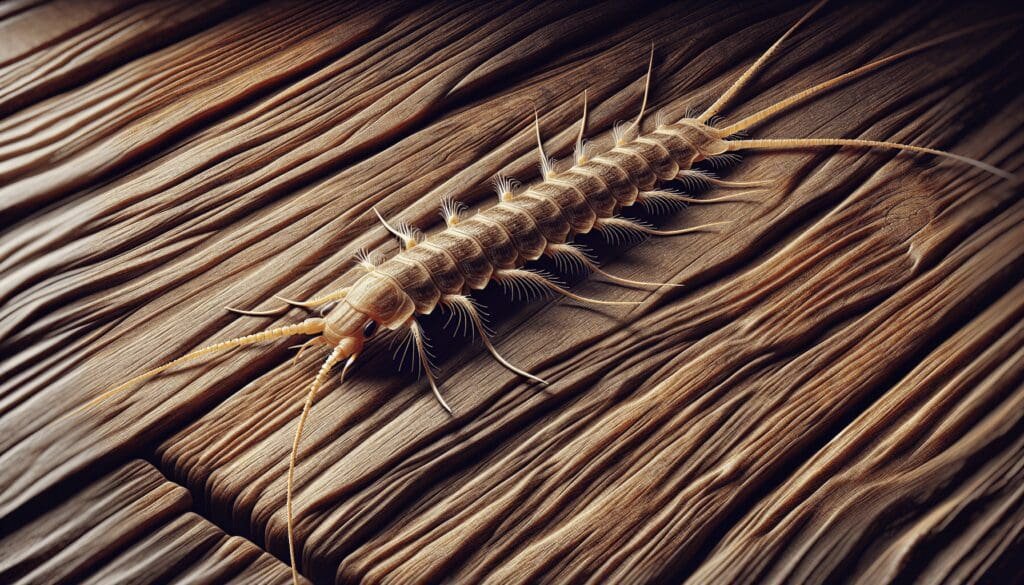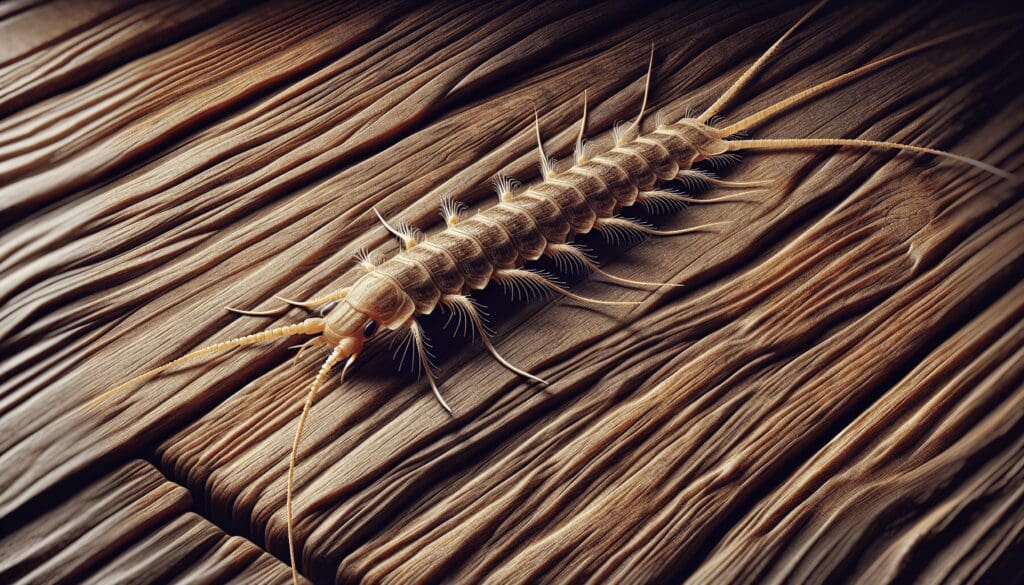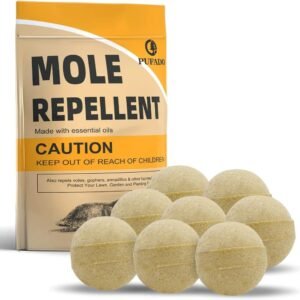Curiosity piqued? Wondering if those tiny little creatures known as silverfish can actually sink their teeth into human flesh? Well, fear not, because this friendly article is here to put your mind at ease. So, where do silverfish come from? What are they exactly? Can they lay eggs in your house? Do they have wings? Can they munch on your beloved clothing? And the big question – can they bite you? Stick around and we’ll answer all these burning questions and more. Let’s dive into the fascinating world of silverfish and explore their habits, preferences, and capabilities together.
Understanding Silverfish
Description and identification of silverfish
Silverfish are small, wingless insects that are typically silver or gray in color. They have a slender, elongated body and move in a distinctive fish-like manner, hence their name. They are about half an inch long on average, with three tail-like appendages at the rear of their bodies. Silverfish have a characteristic tapered shape, with a flat head and a long abdomen. They also have scales covering their bodies, giving them a shimmery appearance.
Silverfish habitat and source
Silverfish are nocturnal creatures and prefer dark, damp environments. They are commonly found in bathrooms, kitchens, basements, and attics, as these areas often provide the moisture and humidity they thrive in. Silverfish are also known to seek shelter in cracks, crevices, and hidden corners during the day. They are agile climbers and can access high shelves and storage areas easily. Silverfish are often introduced into homes through infested cardboard boxes, books, or other items brought in from outside.
Life Cycle of Silverfish
Silverfish reproduction
Silverfish reproduce through a process called “traumatic insemination,” where the male stabs the female’s abdomen with his reproductive organ. After mating, the female silverfish can lay between 2 to 20 eggs at a time.
Can silverfish lay eggs in houses?
Yes, silverfish can lay eggs in houses. The female silverfish typically lays her eggs in cracks, crevices, and hidden areas, making them difficult to spot. These eggs are white and oval-shaped, resembling grains of rice. The eggs usually hatch within 2 to 8 weeks, depending on environmental conditions.
Lifespan of silverfish
Silverfish have a relatively long lifespan compared to other insects. They can live anywhere from 2 to 8 years, depending on various factors such as temperature, humidity, and availability of food.
Mobility of Silverfish
Natural movement of silverfish
Silverfish are agile and quick movers. They have a distinctive wiggling motion that resembles the swimming of a fish, which allows them to move easily through tight spaces and climb walls.
Do silverfish insects fly?
No, silverfish do not have wings and therefore cannot fly. They rely on their ability to crawl and climb to navigate their surroundings.
Dietary Habits of Silverfish
What silverfish eat in natural and domestic environments
Silverfish are nocturnal scavengers and have a diverse diet. In their natural environment, they feed on carbohydrates, such as starches and polysaccharides, found in decaying plant matter, mold, and fungi. In domestic environments, they can feed on a variety of household items, including books, paper, wallpaper paste, clothing, and even food items left unsealed.
Can Silverfish eat clothes?
Yes, silverfish can eat certain types of clothes, especially those made of natural fibers like cotton, linen, and silk. They are attracted to the starchy substances found in these fabrics. Synthetic materials, such as polyester or nylon, are generally less appealing to silverfish.
Health Risks Associated with Silverfish
Do silverfish carry diseases?
While silverfish are not known to carry or transmit diseases to humans, their presence in large numbers can pose a risk to individuals with allergies or asthma. Additionally, their shed scales and excrement can contribute to indoor air pollution, potentially causing respiratory issues in sensitive individuals.
The role of silverfish in allergies
Silverfish themselves are not a common trigger for allergies. However, their presence in large numbers can contribute to increased moisture and humidity levels, creating an ideal environment for mold and fungi growth. These allergens can cause allergic reactions in susceptible individuals.
Are silverfish capable of biting humans?
Silverfish do not have the ability to bite humans. They lack the mouthparts necessary for biting or stinging. However, their presence can be unnerving, and the damage they cause to belongings and structures can be frustrating.
Direct and indirect adverse effects of silverfish on human health
While silverfish do not pose significant direct health risks to humans, their presence can indirectly affect human health. The allergens they produce can trigger asthma attacks or allergic reactions in sensitive individuals. Additionally, their feeding habits can result in damage to personal belongings and the structure of houses, leading to potential safety hazards.
Damage Caused by Silverfish
What damage do silverfish cause at home?
Silverfish can cause significant damage to various items commonly found in homes. They are particularly attracted to paper, books, photographs, and cardboard. They can chew on these items, leaving behind small holes and yellowish stains. Silverfish can also cause damage to wallpapers, curtains, and clothing, especially those made of natural fibers.
Potential impact of silverfish on valuable items and structure of houses
The damage caused by silverfish can be particularly concerning when it comes to valuable or irreplaceable items such as antique books, photographs, or important documents. Additionally, if left unchecked, silverfish can damage the structure of houses by feeding on wallpaper glue or even weakening the integrity of wooden structures. This can lead to costly repairs and compromises to the safety of the home.
Silverfish and Allergies
Triggers for allergic reactions
While silverfish themselves are not a typical trigger for allergies, the allergens associated with their presence, such as mold and fungi, can cause allergic reactions. These allergens can be especially problematic for individuals with pre-existing respiratory conditions or sensitivities.
Do silverfish cause allergies?
While silverfish do not directly cause allergies, their presence can contribute to the growth of mold and fungi, which are common triggers for allergic reactions. It is important to address silverfish infestations promptly to minimize the risk of allergen exposure.
Common Signs of Silverfish Infestation
Key signs of silverfish presence in homes
There are several signs that indicate a silverfish infestation in homes. Some common signs include:
- Sightings: Spotting live silverfish, especially during the night, is a clear indication of their presence.
- Shed skins: Silverfish shed their scales and exoskeletons as they grow. Finding these shed skins in dark, hidden areas suggests an active infestation.
- Yellowish stains: Silverfish excrement can leave behind yellowish stains on paper, fabric, or other surfaces.
- Damage to books and paper: The presence of small holes or chewed edges in books, paper items, or cardboard boxes may indicate silverfish activity.
Frequency and locations of sightings
Silverfish are nocturnal insects, so sightings during the day are relatively rare. However, if you notice frequent sightings at night, especially in areas with high humidity or moisture, it is a sign of a potential infestation. Common locations for sightings include bathrooms, kitchens, basements, and attics.
Physical evidence of silverfish activity including damage
Physical evidence of silverfish activity includes the presence of shed skins, yellowish stains from excrement, and damage to books, paper, or fabric. It is important to address these signs promptly to prevent further damage and infestation spread.
Methods to Get Rid of Silverfish
DIY Techniques for silverfish elimination
If you have a minor silverfish infestation, you can try several do-it-yourself techniques to eliminate them. Some effective methods include:
- Reduce moisture: Silverfish thrive in humid environments, so using dehumidifiers or fixing plumbing leaks can help make your home less attractive to them.
- Remove food sources: Store food items in airtight containers and clean up any spills or crumbs that may attract silverfish.
- Vacuum regularly: Regular vacuuming helps remove silverfish and their eggs, as well as any food particles that they might be attracted to.
- Use natural deterrents: Certain essential oils, such as lavender or citrus, can act as natural repellents for silverfish. Applying these oils in areas of infestation may help deter them.
Professional pest control options for silverfish
For severe or persistent silverfish infestations, it is recommended to seek professional pest control services. Pest control professionals have the knowledge and experience to effectively eliminate silverfish and prevent future infestations. They may use a combination of chemical treatments, insecticides, and targeted strategies to address the issue.
How do you get rid of silverfish?
To get rid of silverfish, it’s important to address the underlying factors that attract them to your home. This includes reducing moisture, removing food sources, and implementing prevention measures. Utilizing a combination of DIY techniques and professional pest control, if necessary, can help effectively eliminate silverfish and prevent future infestations.
Preventing Silverfish Infestations
Steps to make your home less attractive to silverfish
To make your home less attractive to silverfish and minimize the risk of infestations, follow these steps:
- Reduce moisture: Fix any plumbing leaks, improve ventilation in damp areas, and use dehumidifiers to control humidity levels.
- Seal cracks and crevices: Silverfish can enter through tiny openings, so sealing cracks and crevices can help prevent their entry.
- Store food properly: Keep food items in sealed containers, clean up spills promptly, and minimize food sources that may attract silverfish.
- Declutter regularly: Remove unnecessary items and debris from your home, as these can provide hiding places for silverfish.
- Regular cleaning: Vacuum regularly, especially in areas prone to silverfish infestations, and keep your home clean and free from food debris.
Regular maintenance and housekeeping practices to prevent infestations
Maintaining good housekeeping practices is crucial in preventing silverfish infestations. Some key practices include:
- Regularly inspecting and cleaning storage areas, such as attics, basements, and closets.
- Regularly dusting and vacuuming to remove potential food sources and silverfish eggs.
- Sealing cracks and gaps in walls, baseboards, and windows to prevent silverfish entry.
- Keeping the home well-ventilated and ensuring good air circulation to discourage excessive humidity.
By implementing these preventive measures and maintaining a clean and well-maintained home, you can greatly reduce the risk of silverfish infestations.








